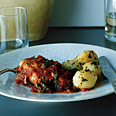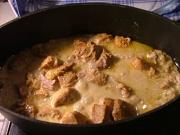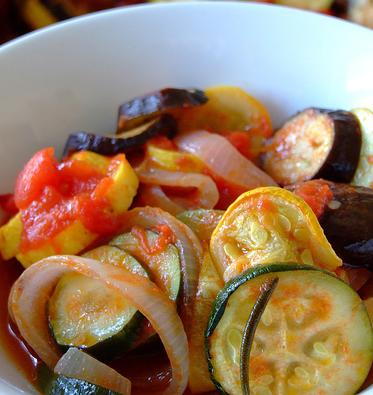Au Resto, pronounced oh resto, means “at the restaurant.” Despite all appearances to the contrary, most French people love short cuts, nicknames and, of course, breaking the rules. Grammatical ones included. However this is only acceptable if you know you know the rules you are breaking.
So this post will give you a few short cuts and hints to have a better experience eating in France. The goal is to help you figure out the menu and decide what to order. If you’re looking for hints on tipping and getting the waiters attention, read this previous post.
French food is a vast subject and French menus can be quite puzzling to visitors. These days, many people in the US and other English-speaking countries are accustomed to restaurants that go out of their way to provide an exhaustive list of ingredients and cooking methods in the short description of each dish.
For example:
 Chicken Provencal – A free-range bonless chicken breast, lightly marked on the grill and seasoned with Herbes de Provence. Served with an heirloom tomato-eggplant ratatouille spiked with house-made preserved Yuzu and finished in the oven with a toasted parmesan, cracked white pepper crust and a drizzle of extra-virgin olive oil and fresh herbs.
Chicken Provencal – A free-range bonless chicken breast, lightly marked on the grill and seasoned with Herbes de Provence. Served with an heirloom tomato-eggplant ratatouille spiked with house-made preserved Yuzu and finished in the oven with a toasted parmesan, cracked white pepper crust and a drizzle of extra-virgin olive oil and fresh herbs.
I just made that dish up, but you get the idea. Well, in France the menu would most likely say, Poulet Provençal et sa ratatouille. Nothing more. The English translations are often not much more help, something like “Provençal Style Chicken and its Ratatouille Vegetables.”
Like so many other things here, you’re just supposed to know how this dish is made. But for visitors this causes two levels of distress. If you already know some French food vocabulary, that helps enormously. But if you don’t know how to decipher the hints about the preparations you can still be lost deciding what to order.
Once you have figured out the meat, in this case Poulet = Chicken, the first clue is to think about the origin of the word describing the chicken. French food is often a mix of regional specialties: Provençal = Provence, Normand = Normandy, Bourguignon = Burgundy.
So when you see the word Provençal think of Provence. Near the border of Italy, expect tomatoes, basil and other Mediterranean herbs, olive oil and of course garlic. Albeit in very small doses, most French people seem to have an aversion to Garlic.
 Normand. In Normandy they are famous for milk and cream, apples and Calvados, a strong alcohol made from apples that is the regional equivelant to a Cognac or an Armagnac. One classic is Sauté de Porc Normand - sautéed tenderloin of Pork with a cream sauce.
Normand. In Normandy they are famous for milk and cream, apples and Calvados, a strong alcohol made from apples that is the regional equivelant to a Cognac or an Armagnac. One classic is Sauté de Porc Normand - sautéed tenderloin of Pork with a cream sauce.
Bourguignon. The dish most most commonly known outside France is Beef Bourguignon. Slowly-cooked from fatty cuts of beef and made with lots of red wine from Burgundy.
So back to the case of our Poulet Provencale et sa Ratatouille, this is chicken dish cooked Provençal style with tomatoes, Mediterranean herbs, garlic and olive oil. "Sa ratatouille" means the Ratatouille that goes along with it.
 No Provencal meal would be complete without this slow-cooked preparation of Eggplant, Tomato, Onions, Garlic and herbs drizzled with Olive Oil. You get the idea. Sometimes the classic ingredients are changed to include Zucchini aka Courgette instead of eggplant. In this case the menu would say “Ratatouille au Courgette.” This is my preference since I’m not a fan of Eggplant.
No Provencal meal would be complete without this slow-cooked preparation of Eggplant, Tomato, Onions, Garlic and herbs drizzled with Olive Oil. You get the idea. Sometimes the classic ingredients are changed to include Zucchini aka Courgette instead of eggplant. In this case the menu would say “Ratatouille au Courgette.” This is my preference since I’m not a fan of Eggplant.
BTW, a garlicy Ratatouille aux Courgettes makes a great accompaniment for seared Beef, especially Black Pepper-marinated Flank Steak sliced thin across the grain of the meat. This would be great with a hearty red wine from the Rhone - made primarily of Syrah.
When I was quite young and started to visit France, I didn’t speak any French and was a less adventurous eater than the one I evolved into. We were deep in the countryside and stopped along the way at a small village restaurant. I was travelling with a friend who knew a little French. Quite helpful as no one in this small place spoke any English. He helped translate the more common words and since it was a chilly night I decided to take the hearty-sounding Veal and Rice Stew called “Riz de Veau.” When it arrived there was no sign of stew and just a few small wrinkled pieces of tender meat. Slowly we realized that this was not Veal and Rice, but Veal thalamus glands, called Riz de Veau, commonly called Sweetbreads in English. That’s what is referred to a Faux Ami – a False Friend. This describes a word or words that sound like they should be one thing in English and are actually something completely different. Needless to say, J and I were hunting for a sandwich after that meal.
This is just a start on helping you order in French, so I promise to keep posting about how to translate French menus and offer helpful tips for making the most of your visit to Paris.
Here is a menu of the primary meats found on Menus in French restaurants with English translations. I have also included some of the more common cuts:
Poulet Chicken
Supreme Breast
Cuisse Thigh
Aile Wing
Boeuf Beef
Piece de Boeuf Roast Beef
Onglet Steak cut from the back
L’Entrecôte Steak cut from the ribs
Tournados Similar to Filet Mignon (but usually cut thinner)
Porc Pork
Filet Mignon Pork Tenderloin
Côte du Pork Chop
Canard Duck
Cuisse Thigh
Magret Breast
Biche Vennison
Selle Saddle
Gigot Leg
L’Agneau Lamb
Gigot Leg
Cote Chop
Cotelettes Little chops
Selle Saddle
Veau Veal
Poisson Fish
Rouget Red Mullet (Often very small filets)
Thon Tuna
L’Espadon Swordfish
Lotte Sea Bass
St Pierre John Dory
Cabillaud or Morue Cod
Maquereaux Mackerel
Sole Sole
Escargot Snails
Grenouille Frog
Coquilles St Jacques Scallops
Riz de Veau Sweetbreads
Lapin Rabbit
Liève Wild Hare
Photo Credits:
Chicken Provencal - Gourmet Magazine via epicurious.com
Sauté of Pork Normand - Courtesy of Plat de Jour
Ratatouille - La Petit Gourmande Blog